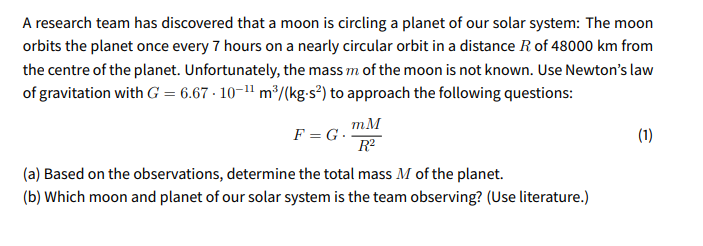A research team has discovered that a moon is circling a planet of our solar system: The moon orbits the planet once every 7 hours on a nearly circular orbit in a distance R of 48000 km from the centre of the planet. Unfortunately, the mass m of the moon is not known. Use Newton's law of gravitation with G = 6.67 · 10-1" m³/(kg-s²) to approach the following questions: mM F = G. (1) R (a) Based on the observations, determine the total mass M of the planet. (b) Which moon and planet of our solar system is the team observing? (Use literature.)
A research team has discovered that a moon is circling a planet of our solar system: The moon orbits the planet once every 7 hours on a nearly circular orbit in a distance R of 48000 km from the centre of the planet. Unfortunately, the mass m of the moon is not known. Use Newton's law of gravitation with G = 6.67 · 10-1" m³/(kg-s²) to approach the following questions: mM F = G. (1) R (a) Based on the observations, determine the total mass M of the planet. (b) Which moon and planet of our solar system is the team observing? (Use literature.)
Related questions
Question

Transcribed Image Text:A research team has discovered that a moon is circling a planet of our solar system: The moon
orbits the planet once every 7 hours on a nearly circular orbit in a distance R of 48000 km from
the centre of the planet. Unfortunately, the mass m of the moon is not known. Use Newton's law
of gravitation with G = 6.67 · 10-1" m³/(kg-s²) to approach the following questions:
mM
F = G.
R?
(1)
(a) Based on the observations, determine the total mass M of the planet.
(b) Which moon and planet of our solar system is the team observing? (Use literature.)
Expert Solution
This question has been solved!
Explore an expertly crafted, step-by-step solution for a thorough understanding of key concepts.
This is a popular solution!
Trending now
This is a popular solution!
Step by step
Solved in 5 steps
